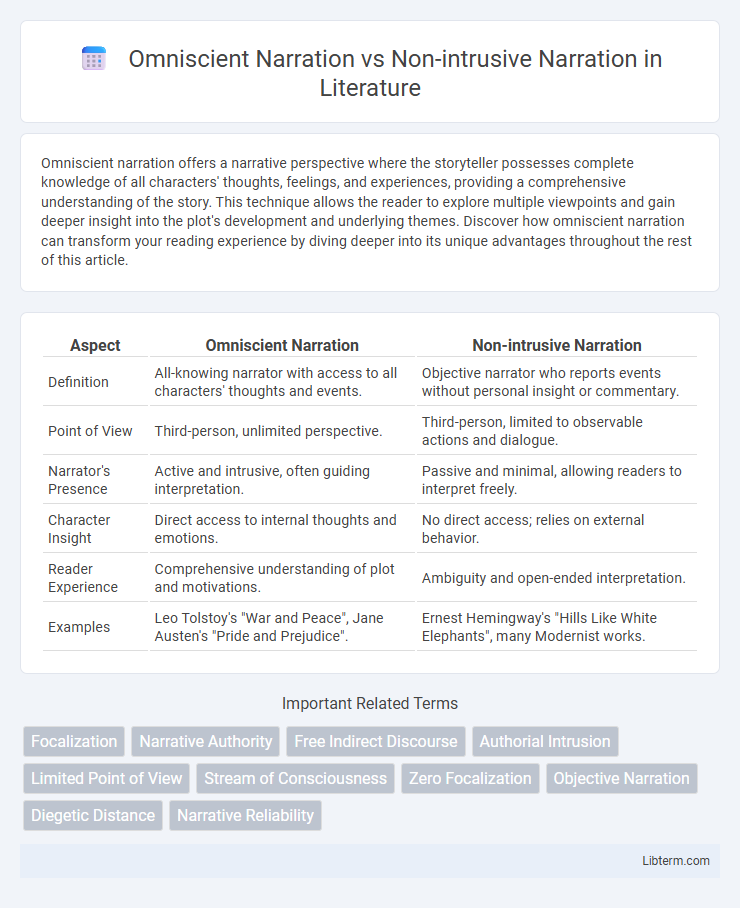Omniscient narration offers a narrative perspective where the storyteller possesses complete knowledge of all characters' thoughts, feelings, and experiences, providing a comprehensive understanding of the story. This technique allows the reader to explore multiple viewpoints and gain deeper insight into the plot's development and underlying themes. Discover how omniscient narration can transform your reading experience by diving deeper into its unique advantages throughout the rest of this article.
Table of Comparison
| Aspect | Omniscient Narration | Non-intrusive Narration |
|---|---|---|
| Definition | All-knowing narrator with access to all characters' thoughts and events. | Objective narrator who reports events without personal insight or commentary. |
| Point of View | Third-person, unlimited perspective. | Third-person, limited to observable actions and dialogue. |
| Narrator's Presence | Active and intrusive, often guiding interpretation. | Passive and minimal, allowing readers to interpret freely. |
| Character Insight | Direct access to internal thoughts and emotions. | No direct access; relies on external behavior. |
| Reader Experience | Comprehensive understanding of plot and motivations. | Ambiguity and open-ended interpretation. |
| Examples | Leo Tolstoy's "War and Peace", Jane Austen's "Pride and Prejudice". | Ernest Hemingway's "Hills Like White Elephants", many Modernist works. |
Understanding Omniscient Narration
Omniscient narration provides a comprehensive perspective by revealing the thoughts, feelings, and motivations of multiple characters, offering readers a deeper understanding of the story's inner workings. This narrative style allows seamless shifts between characters and settings, enriching the plot with a multifaceted viewpoint that enhances thematic complexity. In contrast, non-intrusive narration maintains a limited viewpoint, presenting events objectively without authorial commentary or insight into internal states.
Defining Non-intrusive Narration
Non-intrusive narration immerses readers by presenting the story through an observational lens without the narrator's explicit commentary or judgments, allowing events and characters to unfold naturally. This style contrasts with omniscient narration, where the narrator possesses comprehensive knowledge of all characters' thoughts and motives and often interjects with insights. By maintaining narrative distance, non-intrusive narration fosters a more subtle and immersive storytelling experience, emphasizing "show, don't tell" techniques.
Historical Roots of Omniscient Narration
Omniscient narration traces its origins back to classical literature, rooted in ancient epics like Homer's "Iliad" and "Odyssey," where the narrator possesses an all-encompassing knowledge of characters and events. This narrative style allows the storyteller to provide comprehensive insights into multiple characters' thoughts, emotions, and motivations, establishing a god-like perspective crucial for epic storytelling. In contrast, non-intrusive narration emerged as a reaction during the rise of modernist literature, emphasizing limited narrator presence and objectivity to offer readers a more immersive and unbiased experience.
Key Traits of Non-intrusive Narration
Non-intrusive narration maintains an objective and detached tone, allowing readers to interpret the story without the narrator's direct opinions or emotional input. It primarily focuses on external actions and dialogue, avoiding internal thoughts or unsolicited commentary to preserve narrative neutrality. This style supports immersive storytelling by letting characters and events unfold naturally, emphasizing "show, don't tell.
Voice and Presence: Narrative Distance Explained
Omniscient narration offers a distinct authorial voice with complete access to characters' thoughts, emotions, and backstories, creating a close narrative presence that guides the reader through the story's inner workings. Non-intrusive narration maintains narrative distance by limiting insight to observable actions and dialogue, preserving the story's ambiguity and allowing readers to interpret motives independently. This difference in voice and presence shapes how immersive or detached the reader feels, influencing emotional engagement and the overall storytelling experience.
Reader Engagement: Impact of Narrative Styles
Omniscient narration offers a comprehensive view of the plot and characters, enhancing reader engagement by providing deep insights into multiple perspectives and internal thoughts. Non-intrusive narration maintains an observational stance, allowing readers to interpret events and emotions independently, fostering a more immersive and personal connection with the story. These distinct narrative styles shape reader involvement by either guiding interpretation through detailed exposition or encouraging active participation in meaning-making.
Pros and Cons of Omniscient Narration
Omniscient narration offers a comprehensive viewpoint, revealing the thoughts and motivations of multiple characters which enriches story complexity and depth. However, this narrative style can overwhelm readers with excessive information and reduce suspense by disclosing too much at once. Its flexibility allows smooth shifts in time and perspective but risks confusing readers if not managed with clarity.
Advantages of Non-intrusive Narration
Non-intrusive narration enhances reader immersion by allowing events to unfold naturally without the narrator's opinions or direct commentary, fostering a more authentic and unbiased experience. This style respects the reader's intelligence, encouraging active interpretation and deeper engagement with the narrative. It also preserves narrative ambiguity and nuance, enriching the story's complexity and emotional impact.
Modern Trends in Narrative Techniques
Modern narrative techniques increasingly favor non-intrusive narration to create immersive storytelling experiences, allowing characters and events to unfold organically without overt authorial commentary. Omniscient narration, while offering comprehensive insights into characters' thoughts and backgrounds, is being adapted with greater subtlety to avoid disrupting narrative flow. The shift towards minimal authorial presence aligns with contemporary demands for authenticity and reader engagement in literature and digital storytelling.
Choosing the Right Narrative Approach for Your Story
Selecting the right narrative approach hinges on the story's perspective and reader engagement goals; omniscient narration offers a comprehensive view of characters' thoughts and actions, enriching plot depth through multi-faceted insights. Non-intrusive narration maintains an objective stance, allowing the story to unfold naturally without the narrator's commentary, fostering immersive and authentic reader experiences. Effective storytelling depends on aligning the narrative style with thematic elements and emotional resonance to amplify the impact and clarity of the narrative.
Omniscient Narration Infographic

 libterm.com
libterm.com